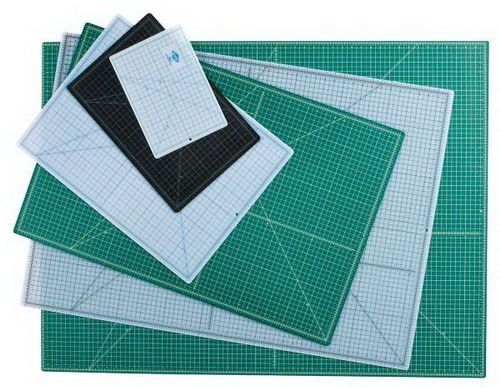In my opinion, I would say cutting mats for quilting are an essential, not an option!
In this article I’ll cover the essentials you need to know about cutting mats, from selection through to storage and cleaning.
Cutting Mats For Quilting
Types
For every job where you make use of either an utility knife or a rotary cutter, you also require a cutting mat.
Cutting mats secure the work surface from damage, and prevent your knife blade from dulling quickly.
Cutting mats are referred to as either hard-surface or self-healing (soft surface).
- Hard-surface (self-sealing) mats are more rigid and more rugged, considering that the blade skims the mat surface without cutting into it.
- Self healing types are thinner and more flexible and typically have a thin layer of colored vinyl on the cutting surface. Cutting blades create tiny scratches in the mat surface that reclose later; hence the description “self-healing.”
Both types are appropriate for quilting.
Size
In general, select the largest mat that fits the work and storage are available. If making use of a rotary cutter to cut pattern pieces, a full-size cutting table mat is ideal. For quilting however, you can get away with a smaller one, it’s just not so easy to cut long strips.
For quilting, a fabric cutting mat 24″ or larger lets you cut strips throughout the fabric width with only a single fold; meaning you get greater precision.
Density
Self healing cutting mats are typically either 2 millimeters (mm) or 3 mm in density.
- 2 mm mats are often referred to as “hobby craft mats” and are not ideal for straight knife use. 2mm mats are more of a “hobby grade” mat and are not a professional-grade mat. On poor quality mats the laminations will separate.
- Professional-quality self-healing cutting mats are 3 millimeters thick and made of 3 plies. The external plies are.75 mm thick and make the mat self-healing . The inner core is 1.5 mm thick and prevents mat cut-through and extends blade life.
 What Tools Can Be Used?
What Tools Can Be Used?
When looking for a cutting mat, ensure you have a good quality rotary cutter. To avoid leaving cut marks in a self-recovery cutting mat, keep checking to make sure your blade is sharp. Change blades frequently if you use your rotary cutter a lot.
When used with dull blades, remember that the majority of any plastic surface will leave a knife mark. Do not invest huge $$$ on a cutting mat and skimp on blades.
Surface Texture
The mat should have a medium “tooth” one that is not too slick or too rough. It should also have a non-glare surface . Thin, 2 mm mats and hobby-grade mats have a tendency to have either too much or too little tooth.
Measurements
You ought to search for a mat that is finished and fully numbered on all four sides of the mat.
Hash lines must extend past the board of the mat on all four sides. The hash lines and full graduations on all sides help with positioning.
Make sure the mats have lines for cutting diagonals. The lines on a cutting mat are generally thick, which minimizes accuracy, and they’re also subject to use and distortion over time.
Tips for cleaning your cutting mat
- To extend the life of any cutting mat, keep it clean. Use a simple all-purpose home spray cleaner or warm water and light detergent.
- Avoid abrasive cleansers and solvents that can destroy the mat or get rid of the printed markings.
- Use a lint roller or a napped lint brush to eliminate surface area lint and fabric crumbs.
- A nylon net scrubber can be utilized to loosen any stubborn dirt or debris on your cutting mat.
- Microfiber cleaning cloths/towels can likewise be used to remove small fibers from knife cuts on your cutting mats.
Storage
It is best to store all cutting mats flat; do not roll them. Some self-recovery cutting mats have a convenient hanging hole for simple storage.
Remove rolled cutting mats from their packages immediately.
Direct heat and sunlight will cause warping so keep your cutting mat away from it! The attic is not a good place to store your cutting mat, nor should it be left in a car.
A cold room will cause the cutting mat to brittle and crack
Finally
Cutting mats ultimately wear out, they do not last forever. It depends on quality, usage, keeping blades sharp and caring for it properly. The cutting pressure you use can also make a difference to how long your cutting mat will last.
Buying a good quality cutting mat for your quilting projects is better in the long run, a cheap mat is really just a false economy.
If you’re just beginning and not sure if you’ll “take to” quilting, then by all means pick up a budget one. Otherwise, buy the best your budget will stretch too.
Alvin Professional Cutting Mats come in a range of sizes and colors, are 3 mm thick, have a hanging hole for storage. They also have printed grid lines for 45 and 60 degree angles and 0.5 in. grid lines


I learned a lot from this article. I know much more about buying my next mat as the one I have now is pretty worn out.
Thanks